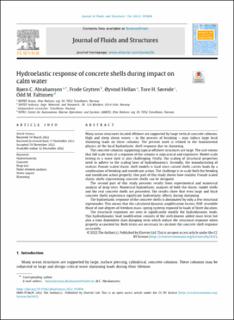| dc.contributor.author | Abrahamsen, Bjørn Christian | |
| dc.contributor.author | Grytten, Frode | |
| dc.contributor.author | Hellan, Øyvind | |
| dc.contributor.author | Søreide, Tore H. | |
| dc.contributor.author | Faltinsen, Odd Magnus | |
| dc.date.accessioned | 2023-10-19T08:05:12Z | |
| dc.date.available | 2023-10-19T08:05:12Z | |
| dc.date.created | 2023-01-12T21:06:51Z | |
| dc.date.issued | 2023 | |
| dc.identifier.issn | 0889-9746 | |
| dc.identifier.uri | https://hdl.handle.net/11250/3097463 | |
| dc.description.abstract | Many ocean structures located offshore are supported by large vertical concrete columns. High and steep storm waves – in the process of breaking – may induce large local slamming loads on these columns. The present work is related to the fundamental physics of the local hydroelastic shell response due to slamming. The concrete columns supporting typical offshore structures are large. The size means that full scale tests of a segment of the column is impractical and expensive. Model-scale testing in a wave tank is also challenging. Firstly, the scaling of structural properties need to adhere to the scaling laws of hydrodynamics. Secondly, the manufacturing of realistic Froude scaled elastic shell models is hard since curved shells carries loads by a combination of bending and membrane action. The challenge is to scale both the bending and membrane action properly. One part of this study shows how realistic Froude scaled elastic shells representing concrete shells can be designed. The second part of this study presents results from experimental and numerical analysis of drop tests. Numerical hydroelastic analyses of both the elastic model shells and the real concrete shells are presented. The results show that even large and thick concrete shells experience significant hydroelastic effects during slamming. The hydroelastic response of the concrete shells is dominated by only a few structural eigenmodes. This means that the calculated dynamic amplification factors, DAF, resemble those of one-degree-of-freedom mass–spring systems exposed to loads of finite duration. The structural responses are seen to significantly modify the hydrodynamic loads. This hydrodynamic load modification consists of the well-known added mass term but also a time dependent slam damping term which reduce the structural response when properly accounted for. Both terms are necessary to calculate the concrete shell response accurately. | en_US |
| dc.description.abstract | Hydroelastic response of concrete shells during impact on calm water | en_US |
| dc.language.iso | eng | en_US |
| dc.publisher | Elsevier | en_US |
| dc.rights | Navngivelse 4.0 Internasjonal | * |
| dc.rights.uri | http://creativecommons.org/licenses/by/4.0/deed.no | * |
| dc.subject | Ikkelineære og dynamiske konstruksjonsproblemer | en_US |
| dc.subject | Nonlinear and dynamic structural analysis | en_US |
| dc.subject | Marin hydrodynamikk | en_US |
| dc.subject | Marine hydrodynamics | en_US |
| dc.title | Hydroelastic response of concrete shells during impact on calm water | en_US |
| dc.title.alternative | Hydroelastic response of concrete shells during impact on calm water | en_US |
| dc.type | Peer reviewed | en_US |
| dc.type | Journal article | en_US |
| dc.description.version | publishedVersion | en_US |
| dc.subject.nsi | VDP::Marin teknologi: 580 | en_US |
| dc.subject.nsi | VDP::Marine technology: 580 | en_US |
| dc.source.volume | 116 | en_US |
| dc.source.journal | Journal of Fluids and Structures | en_US |
| dc.source.issue | 103804 | en_US |
| dc.identifier.doi | 10.1016/j.jfluidstructs.2022.103804 | |
| dc.identifier.cristin | 2106060 | |
| dc.relation.project | Norges forskningsråd: 294748 | en_US |
| dc.relation.project | Norges forskningsråd: 223254 | en_US |
| cristin.ispublished | true | |
| cristin.fulltext | original | |
| cristin.qualitycode | 1 | |

